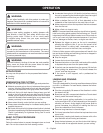
11 — English
CHAIN TENSION
See Figures 13 - 14.
WARNING:
To avoid possible serious injury, never touch or adjust the
chain while the engine is running. The saw chain is very
sharp; always wear protective gloves when performing
maintenance to the chain.
Stop the engine before setting the chain tension. Make
sure the guide bar nut is loose to finger tight, turn the
chain tensioning screw clockwise to tension the chain.
Refer to Replacing the Bar and Chain for additional
information.
NOTE: A cold chain is correctly tensioned when there is
no slack on the underside of the guide bar, the chain is
snug, but it can be turned by hand without binding.
Chain must be re-tensioned whenever the flats on
the drive links hang out of the bar groove as shown in
figure 13.
During normal operation, the temperature of the chain
will increase. The drive links of a correctly tensioned
warm chain will hang approximately .050 in. out of the
bar groove, as shown in figure 14.
NOTE: New chain tends to stretch; check chain tension
frequently and tension as required.
CAUTION:
Chain tensioned while warm, may be too tight upon cool-
ing. Check the “cold tension” before next use.
REPLACING THE BAR AND CHAIN
See Figures 15 - 20.
WARNING:
To avoid possible serious injury, stop engine before re-
placing the bar, chain, or performing any maintenance
operation.
Remove the bar nut and drivecase cover.
The bar contains a bar stud slot that fits over the bar stud.
The bar also contains a chain tensioning pin hole which
fits over the chain tensioning pin.
Place the bar onto the bar stud so that the chain tensioning
pin fits into the chain tensioning pin hole.
Fit the chain over the sprocket and into the bar groove.
The cutters on the top of the bar should face toward the
bar tip, in the direction of the chain rotation.
Replace the drivecase cover and install the bar nut.
Tighten the bar nut finger tight only. The bar must be free
to move for tension adjustment.
Remove all slack from chain by turning the chain tensioning
screw clockwise, assuring that the chain seats into the
bar groove during tensioning.
Lift the tip of the bar up to check for sag. Release the
tip of the bar, and turn the chain tensioning screw 1/2
turn clockwise. Repeat this process until sag does not
exist.
Hold the tip of the bar up and tighten the bar nut
securely.
Chain is correctly tensioned when there is no slack on
the underside of the bar, the chain is snug, but it can be
turned by hand without binding.
NOTE: If chain is too tight, it will not rotate. Loosen the
bar nut slightly and turn adjusting screw 1/4 turn counter-
clockwise. Lift the tip of the bar up and retighten bar nut.
IDLE SPEED ADJUSTMENT
See Figure 21.
If the chain turns at idle, the idle speed screw needs adjusting
on the engine. Turn the idle speed screw counterclockwise
to reduce the idle RPM and stop the chain movement. If
the saw chain still moves at idle speed, contact a service
dealer for adjustment and discontinue use until the repair
is made.
WARNING:
The saw chain should never turn at idle. Turn the idle
speed screw counterclockwise to reduce the idle RPM
and stop the chain, or contact a service dealer for ad-
justment and discontinue use until the repair is made.
Serious personal injury may result from the saw chain
turning at idle.
AUTOMATIC BAR AND CHAIN LUBRICATION
See Figure 22.
Use Premium Bar and Chain Lubricant. It is designed for
chains and chain oilers and is formulated to perform over
a wide temperature range with no dilution required.
Remove the cap and carefully pour approximately 8 oz.
of bar and chain lubricant into the bar lube reservoir.
Replace the cap and tighten securely.
Check and refill the bar lube reservoir every time the
engine is fueled.
NOTE: Do not use dirty, used or otherwise contaminated
lubricant. Damage may occur to the oil pump, bar, or
chain.
CHAIN MAINTENANCE
See Figure 23.
For smooth and fast cutting, the chain needs to be main-
tained properly. The following conditions indicate that the
chain requires sharpening:
MAINTENANCE


















